Qutub Minar and complex comprises many remains of different rulers of India. Located in south Delhi this area is the attraction of many travelers. The history and remains of dynasties went through the journey of building or leaving their traces are in this complex. The highest brick tower in the world is in Delhi of India. A UNESCO world heritage site built to commemorate the victory of Muhammad of Ghor and his general Qutub-ud-din Aibak in the end of 11th century.
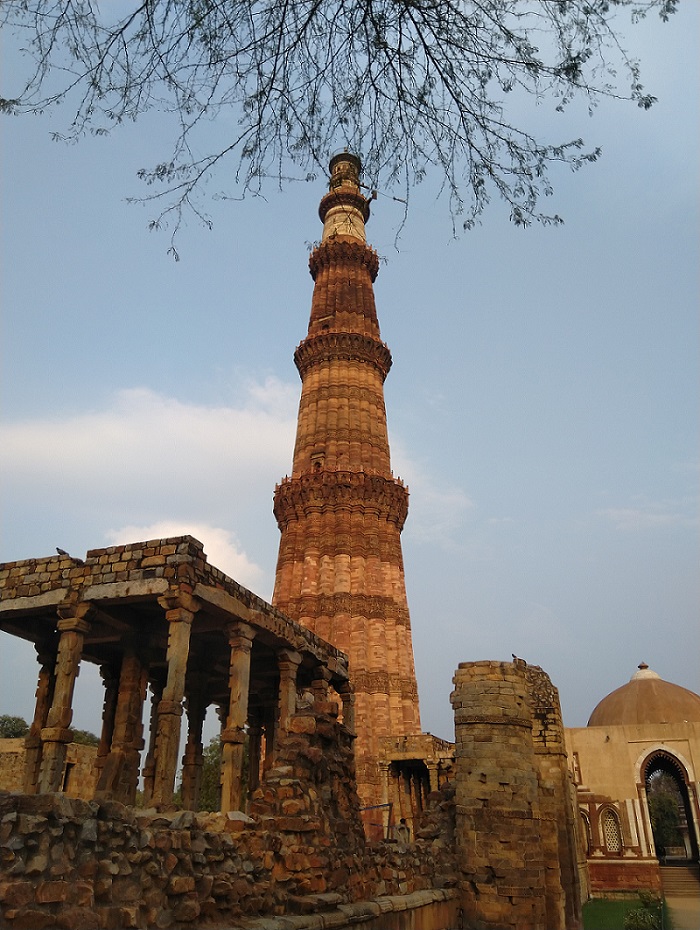
Battle of Tarai
There were conflicts around the world and a time to rule and govern far and formidable areas. This is the time when Muhammad Ghori or Mu’izz ad-din Muhammad of Ghor, led his incursions toward India. Prithavi Raj Chauhan faced the army of Gauri and inflicted a defeat on him with the help of other Rajput clans.
Mu’izz ad-din m Muhammad returned to his home country but this lesson give him lots of understanding of Indian Landscapes, climate, and fighting skills of Rajputs as well as the errors and the mistakes. This understanding from the battle field of Tarain in 1191 pushed him to make a large army with many war skills. He returned to India to fight again in 1192 with the Rajputs in the same battle field of Tarain. Prithavi Raj Chauhan confronted the army but this time his luck and supporters did not help. The army of Ghauri became victorious and India saw a new leaf turning the time with many administrative and cultural changes.
Capture of Delhi and Rise of new Empire
Soon after Mohammad Gauri captured Delhi he ordered to consolidate the new empire in India. Qutbud-ud-din Aibak was his slave, who very soon showed his military genius and became the general of his Army. When Gauri returned to his homeland in Sham he left the administrative charge on the shoulders of Aibak.
He always said that his empire would be cared by his honest and faithful servants as he had no heir descendant to claim his territories. In 1206 Muhammad Gauri died and so Qutbuddin Aibak proclaimed himself the Sultan of India. And this way a slave ultimately found his position and became the Emperor and the founder of Mamluk or slave dynasty in India. The slaves in Arabic termed as Mamluk.
Construction of Qutub Minar and complex
The battle of Tarain in 1192 opened the way for the Muslim rulers to exercise their law in this sub-continent. The Jami Mosque built by Qutbuddin Aibak was the first building, in this complex. It started soon after the domination of the Muslims, in 1193. It is the oldest and biggest mosque in India. The courtyard of the mosque is 43 meter long from East to west and 33 meter wide from north to south.
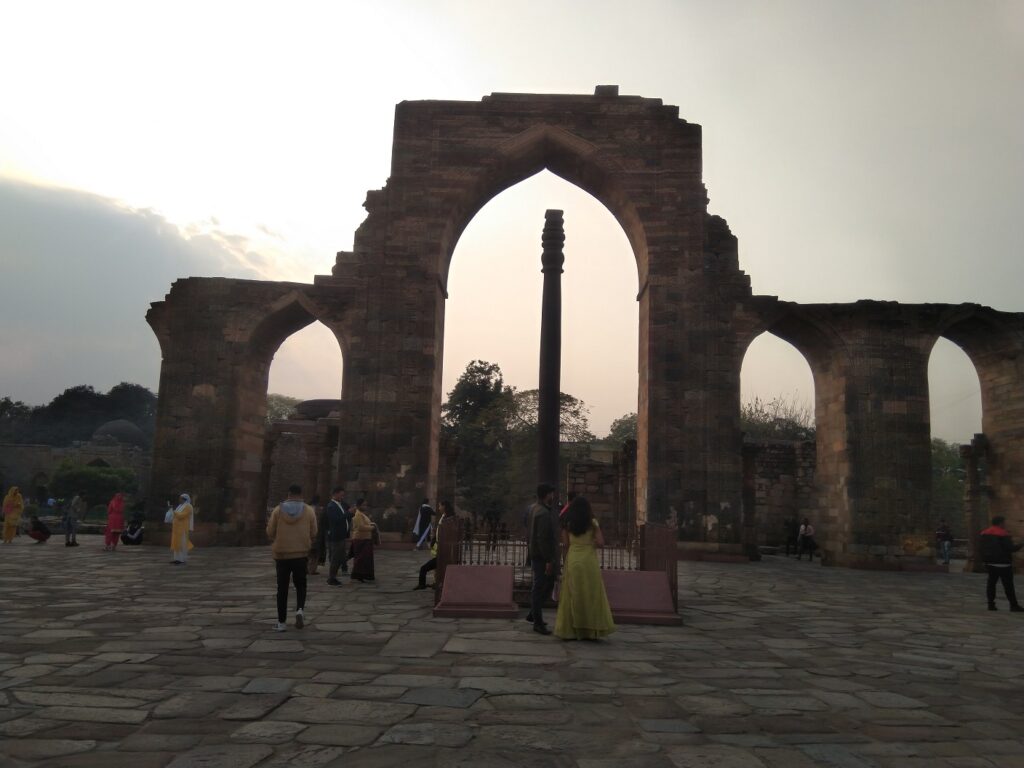
Two door ways provided on the cloisters in the middle of the north and east side. The west side of the mosque has five similar arch facade with many decoration on their surface. One southern arch damaged by nature. The middle arch is the highest. It is 16.4 meter long 6.4 meter wide. The designs on the surface of this arch has floral stems, leafs and flower buds with the Arabic Inscriptions carved and engraved very nicely.
Qutub Minar and complex stone carvings
The stones of many different colors had been used for the front layers, while the structure is strongly built with red and other color sandstone. The top of the arch has many Geometrical and Arabesque pattern which came from the Arabic lands. This Mosque has two double storey chambers in the corners of the eastern side. These were purposefully built to give space to the ladies, who could pray without being seen by any one in the Mosque complex.
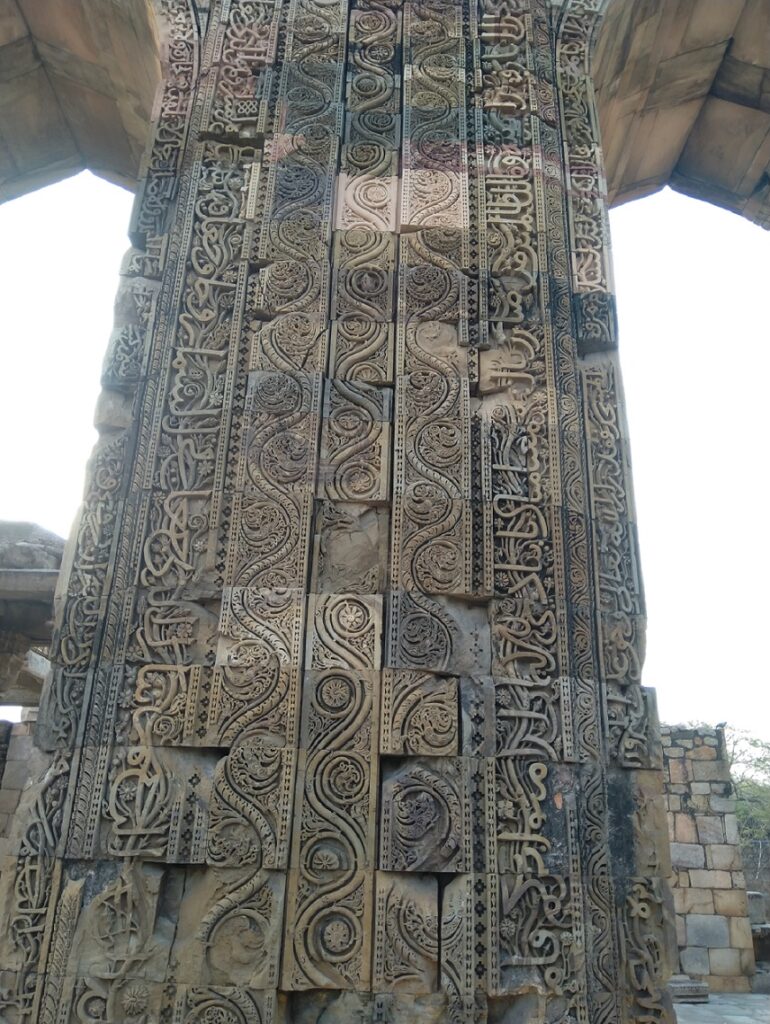
This mosque later known as Might of Islam Mosque, originally built by Qutbuddin Aibak. There is an Iron pillar standing in the middle of the Mosque near the facade. It carries an inscription which says that built for a king named as Chandra Gupta. Built in 4th century the iron pillar show rusting on its lower side but in very slow pace during this 1600 years of its construction. The metal and the metallurgical understanding of the people is really considerable.
Tower associated with Mosque
There are some examples of brick towers built in Gazani, Afghanistan to recall the victory and spread of Islam. There are still Three Minars survived in Afghanistan. Two minarets of 20 meter each still standing in Ghazni of central Afghanistan. Built between first and middle of the 12th century by two rulers of Great Gaznavid Empire. They are standing on a plain with 600 meter apart to each other. They are the surviving parts of the Mosque Bahram Shah.
One brick tower with many decorative inscriptions built in later half of the 12th century. These built for the victorious Ghurid empire who ruled present Afghanistan, north India, parts of Iran and central Asia. This is a UNESCO world heritage site and is only 65 meter high, while Qutub Minar is 72.5 meter. Qutub Minar probably built a little later in 12th century by the slave of Gurid Sultan Mu’izz al-ddin Muhammad.
Some other facts of these Minaretes
Both of the Minarets the Minar of Jam(Sham) and Qutub Minar built almost the same time in 12th century for the same purpose that is the victory tower of Gurid Empire. But the later known as Qutub Minar as the work had been started by Qutbuddin Aibak and it took long time to be completed than Minar of Jam.

Both the Minars associated with their Mosque. The Minar of Jam attached with the Jami Mosque Firozkoh, while the Minar of Qutub-ud-din associated with the Jami Mosque Quwat-ul-Islam Mosque (Might of Islam Mosque). There are stairs inside the Minar for the Muaazzin who call the Aazan for five times prayer.
Qutub Minar and Mosque Extensions
Qutub Minar however started by Qutbuddin Aibak but he died soon after the first storey completed. The other three stories built by Shamshuddin Iltutamish. He became the Sultan after Aibak. He was Aibak servant and later son-in-law, who proclaimed himself Sultan Of Delhi and ruled 1211-36. Iltutamish extended the mosque on the either side of original Quwat-ul-Islam Mosque.
There are carved arch screen on the west side for the Qibla. And on the east of the main Mosque one can find standing stone columns to surround the extended Mosque. In this way the Minar fall in the south-east corner of Iltutamish Mosque. He completed the work of Minar and it finalizes with four stories. Built with red sandstone and decorated with carved panels of Arabic inscriptions.
Some other monuments built by Iltutamish
Iltutamish built his own tomb on the north-west of the main Mosque and behind his extended Mosque arches. It is plain from outside but very intricate designs carved from inside. The dome of this tomb fall two times and replaced by Firoz shah Tughlaq but could not be survived. It is Firoz shah who replaced the 4th story of Qutub Minar in late 13th century and extended it with marble storey. This is because today we find Qutub Minar with five different storeys.
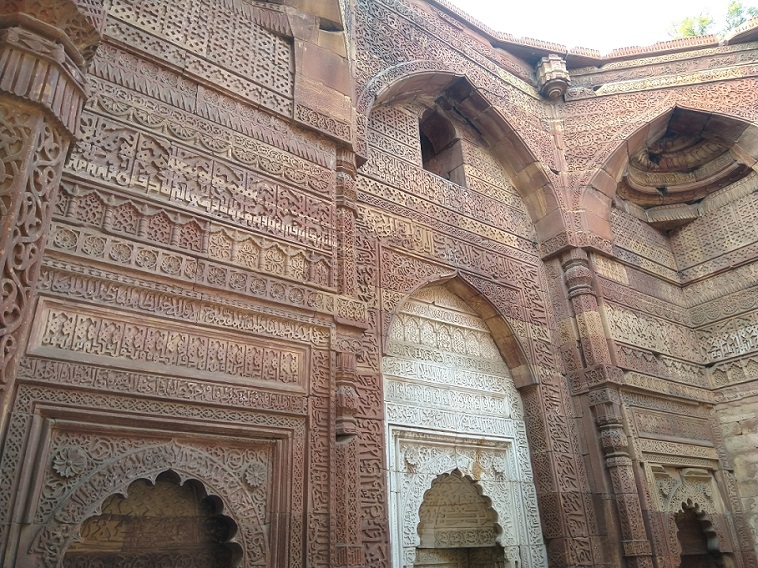
This is because the upper storey got damaged due to the lightning in 1326 and 1364. After the reconstruction, the Minar received some restoration and repair but not such big scale.
The Alai Minar and the Alai darwaza built by Alauddin khalzi was also the part of his extension of the mosque in 13th century. However the Alai Minar could not be completed but exist in this area. There is ruined chambers and tomb area built by Alauddin Khilzi but mostly on the south-west of the main Mosque. Many other ruins and remains of mainly these three Sultans of Delhi are scattered in this Qutub Minar and complex which really a great place dive in the History and cultural assets of India.

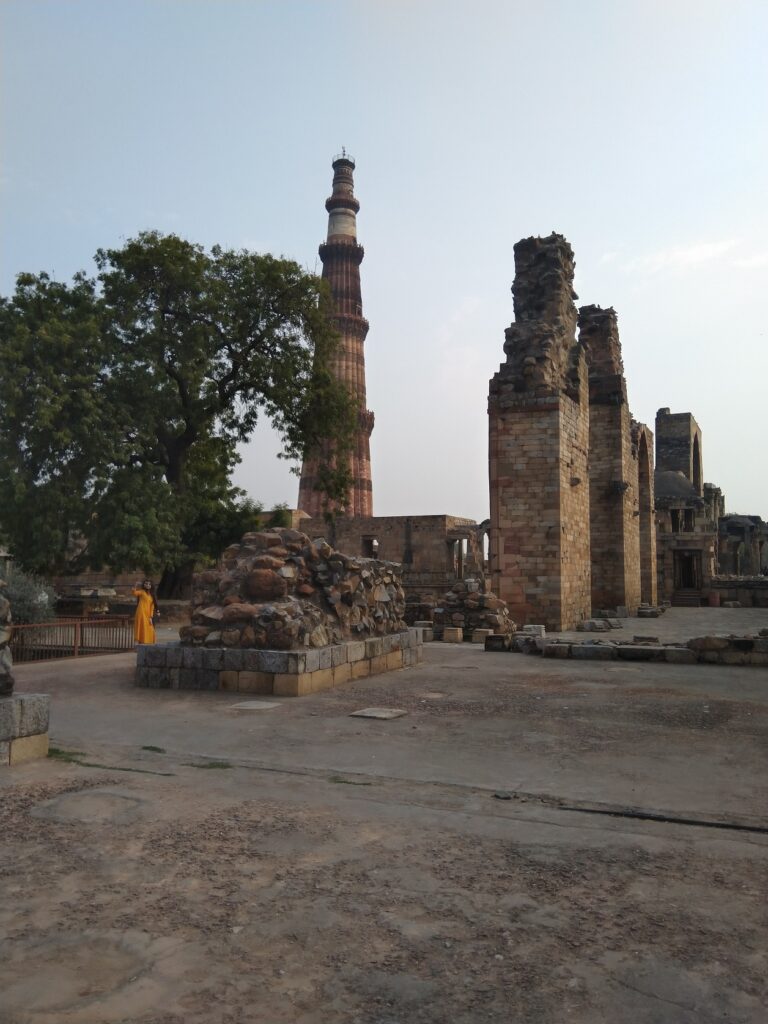
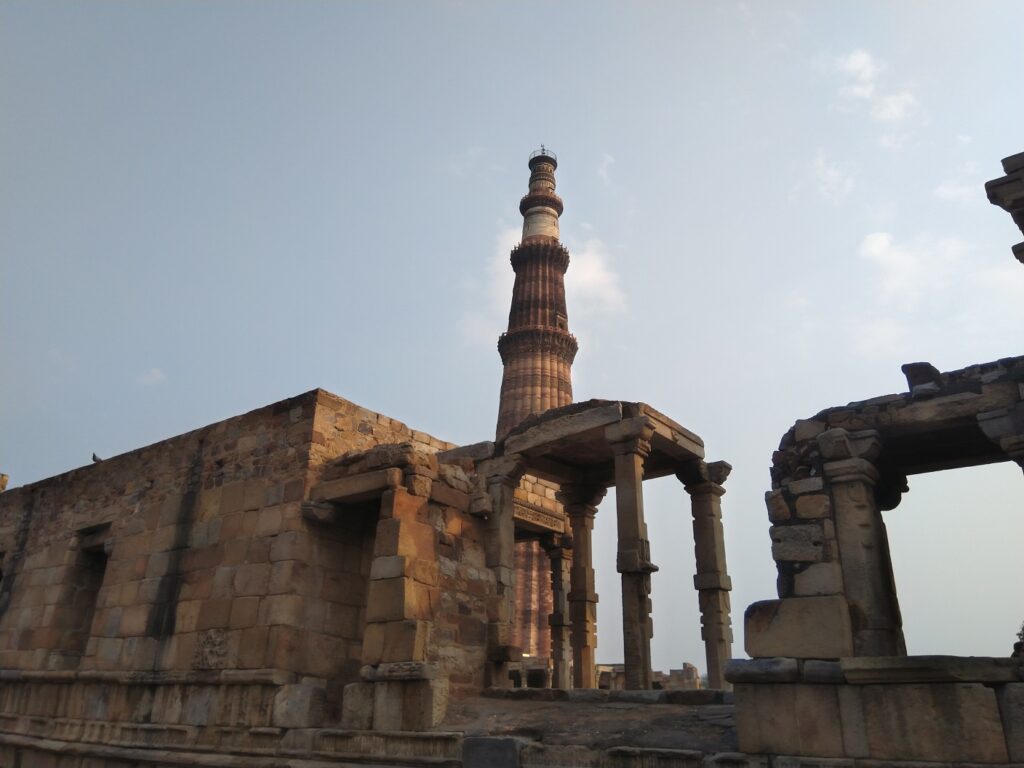
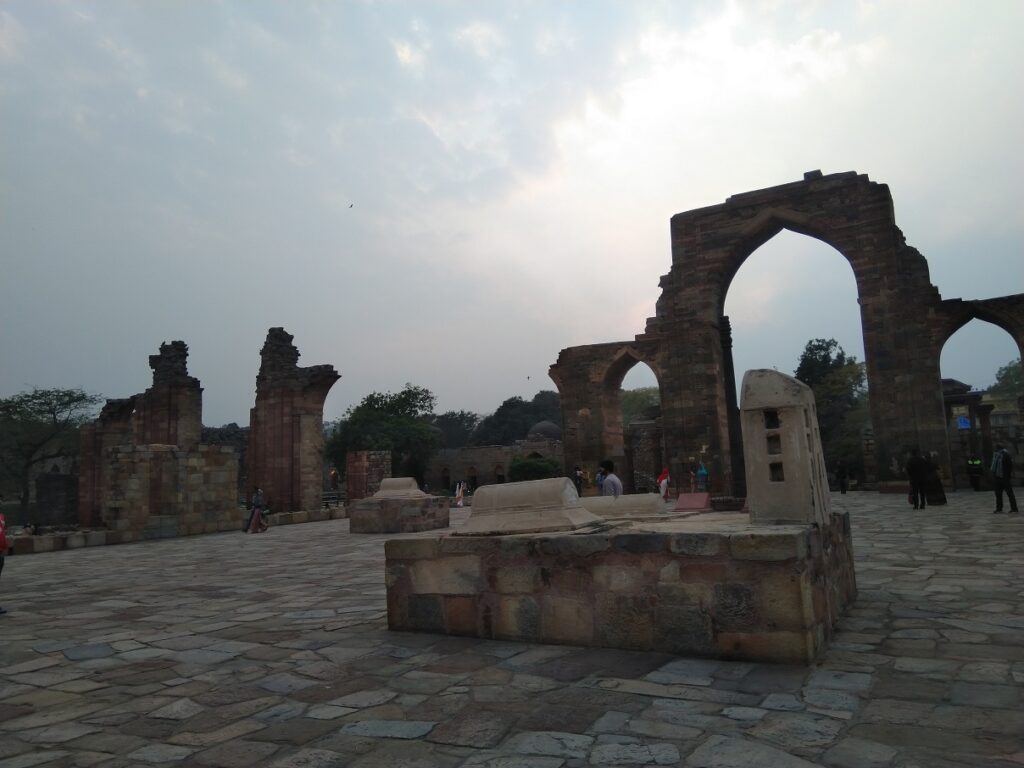
HI, could you please explain more on “There were conflicts around the world and a time to rule and govern far and formidable areas. This is the time when Muhammad Ghori or Mu’izz ad-din Muhammad of Ghor, led his incursions toward India. Prithavi Raj Chauhan faced the army of Gauri and inflicted a defeat on him with the help of other Rajput clans.”. Many thanks. I have bookmarked your website for future use.
Many thanks to understand our view and your kind consideration. We would keep on describing the monument and it’s historical attributes as well as it’s related segments.
Your feedback is always welcome.